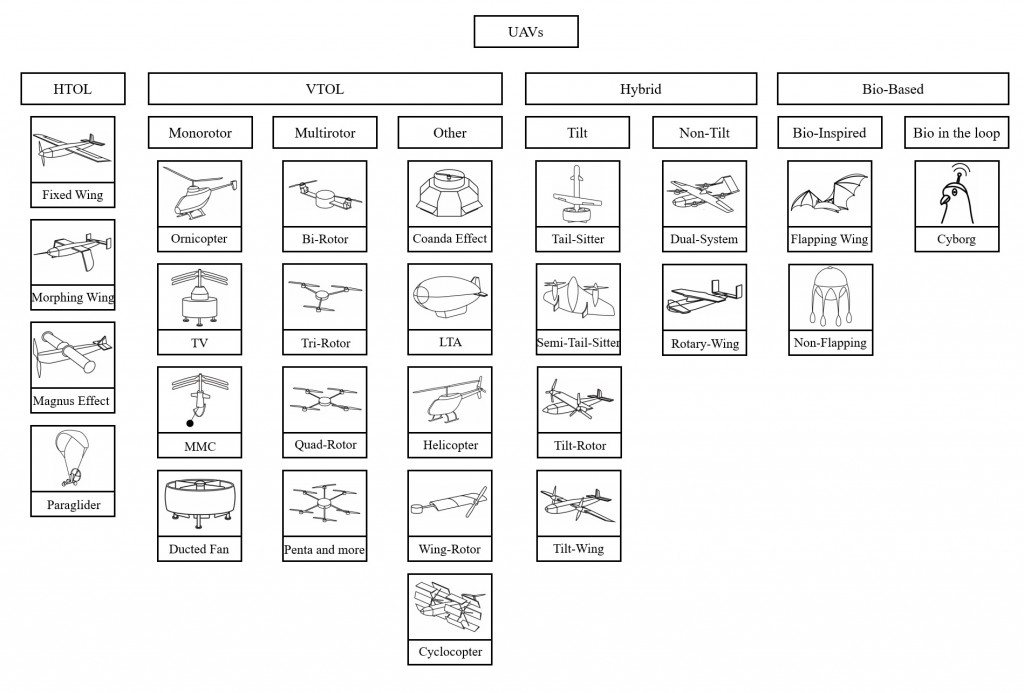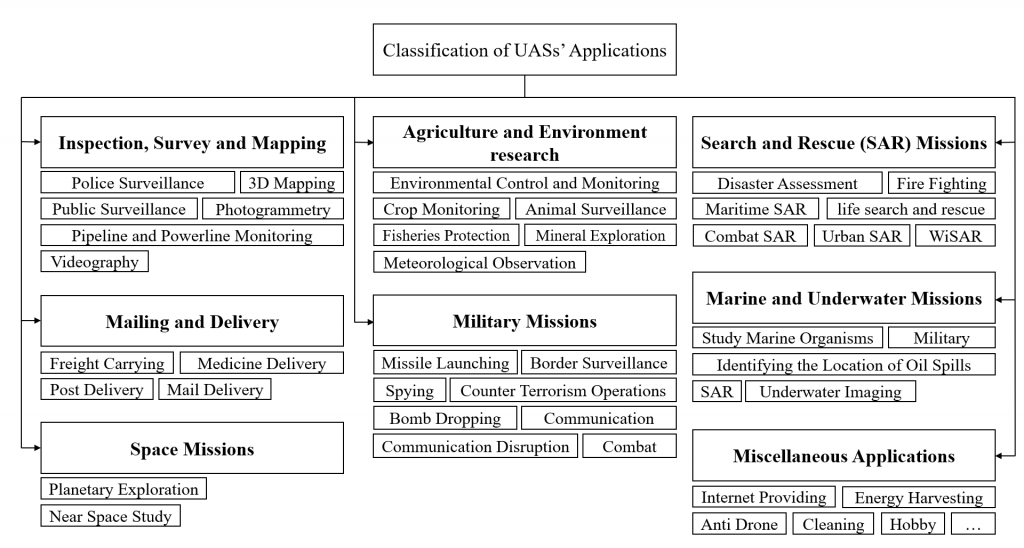
Unmanned Aerial Systems (UAS, UAVs, or drones) have a variety of applications in our daily life that have attracted the attention of many researchers around the world. There are a variety of innovations in the flight mechanisms that drones are applying for flight. Furthermore, there is also a significant interest in the development of new types of drones that can fly autonomously in different locations, such as cities, marine, and space environments to perform various missions.
Main Classification of drones
There are four main categories of UASs, Vertical Takeoff and Landing(VTOL), Horizontal Takeoff and Landing(HTOL), and Hybrid and Bio-Based UASs.
Horizontal Takeoff and Landing UAVs
We can divide HTOL drones into four sub-categories; fixed-wings, morphing wings, Magnus effect UASs, and unmanned para-gliders.
Vertical Takeoff and Landing UAVs
Similarly, we can classify VTOL aerial vehicles into six sub-categories; mono-rotors, multirotor, lighter than air, unmanned helicopters, wing rotors, and cyclocopters. Mono-rotors have also five sub-groups; ornicopters, thrust vectoring mono-rotors, moving mass controlled, Coanda effect UAVs, and ducted-fan mono-rotors.

Multirotors are the most popular drones that have different configurations, including bi-rotors, trirotors, quadrotors, pentarotors, hexacopters, etc. Among multirotors, quadcopters can have different forms that include fixed-rotors, tilt-rotors, moving mass controlled, and Dyson fan configurations.
Hybrid drones
The third category is the hybrid aerial vehicles, which are a combination of VTOL and HTOL UAVs. These types of drones take off and land vertically like VTOLs and have a horizontal cruise flight like HTOLs. Hybrid UASs have two major sub-categories, tilt and non-tilt configurations. Generally, tilt drones use a tilt mechanism to transfer from VTOL to HTOL mode. Some concepts use a tilting body approach and others only rotate the components. Tail-sitter and semi-tail sitter are two major types of tilt-body UAVs. And in Tilt-components category we can mention tilt-rotor and tilt-wing drones. Non-Tilt UAVs are classified into two groups: dual systems and rotary-wings.
We can mention two sub-categories for the bio-based category, bio-inspired and bio-in-the-loop drones. The bio-inspired drones which mimic living creatures like birds, insects, or aquatic animals can be classified into flapping-wings and non-flapping-wings. In the bio in the loop concept, live insects and birds are controlled and used as drones, and bio-materials are integrated into the drones’ structure.
The following figure illustrates the classification of the drones:

Classification of Drones’ Applications
Unmanned Aerial Vehicles (UAVs) have also different applications as well as their configurations resulting applications in a wide range of civilian and military operations. They perform both outdoor and indoor tasks in diverse environments extending from underwater (amphibious UAVs) to space-related missions.
UAVs can be equipped with various sensors and cameras to perform surveillance, reconnaissance, research, and operational and intelligence gathering assignments. The applications of UAVs can be classified in different ways. We can do this based on the type of the mission (civilian or military), type of flight zone (indoor and outdoor), or type of working environment (underwater, on the water, ground, air, space). Nowadays, besides military applications, they are routinely employed in fire-fighting activities, disaster assessment, and mitigation, search and rescue, and multimedia and motion picture industries.
Drones also serve in all types of aerial surveillance, including policing, counter-terrorism operations, large-scale public outdoor events, important objects, VIP security, ground and sea traffic, and environmental pollution control and monitoring.
Telecommunications, crop monitoring, animal surveillance, fisheries protection, mineral exploration, ground mapping and photography, meteorological observation, pipeline and power line inspection, freight carrying, mailing, and delivery, etc. are a few other areas of applications of UASs.

Read More About UAVs
If you are interested in drones, it would be my pleasure to inform you that a comprehensive review paper has been published by me in Progress in Aerospace Sciences (one of the top journals in engineering with IF:8.94 in 2020!), by the name “Configurations, flight mechanisms, and applications of unmanned aerial systems: a review”, about different categories and classification of UAVs and different applications, challenges, and benefits of drones. What you read above was some parts of the paper, I hope it helps you in your research.

